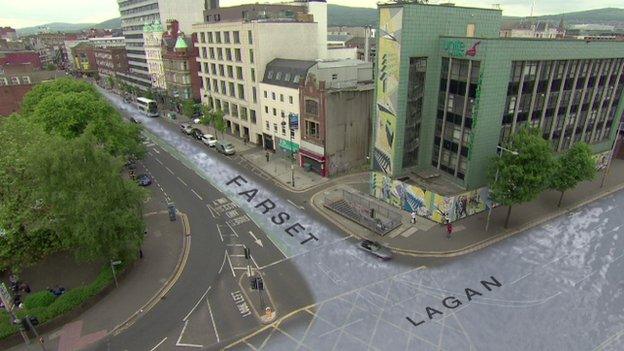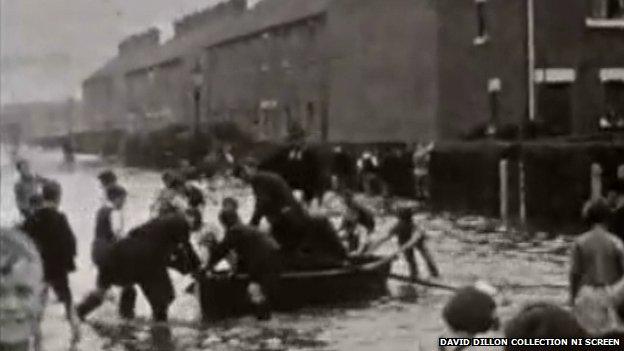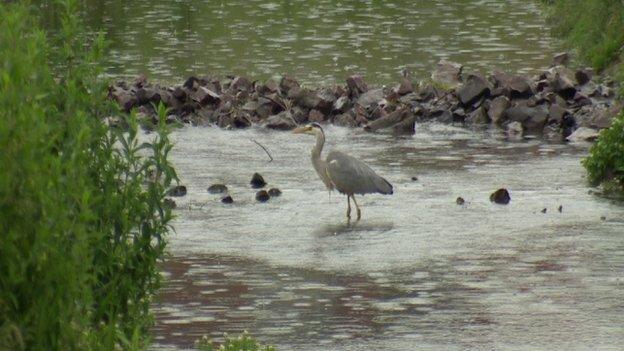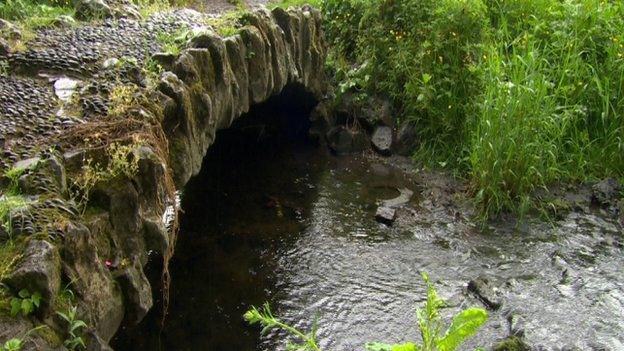Hidden history of Belfast's lesser-known rivers brought to the surface
- Published

A computer image showing the original course of the rivers Farset and Lagan in Belfast
The people of Belfast walk on water.
The streets of Northern Ireland's capital have been built on top of rivers that still flow far below the city's pavements.
Both the Farset and the Blackstaff rivers determined the shape of the city that grew up around the narrowest bridging point of the Farset, where High Street is today.
And the little-known river even gave Belfast its name, Béal feirste (the mouth of the Farset).
Farset itself comes from the Irish word for sandbar.
The history of these hidden rivers is explored in a BBC Newsline series.
BBC News NI's Ita Dungan studies the origins of Belfast's Farset River
Reporter Ita Dungan discovers what the city's defining waterways are like above ground, and what those that are hidden are like below ground.
Old photographs and computer-generated images bring the rivers' histories to life and reveal regeneration plans that are benefitting Belfast's residents and wildlife.
In its heyday, the River Farset powered the linen mills on the Crumlin and Falls Roads.
Its journey takes it from a spring at Squires Hill, far above the city, down into Ballysillan, before cutting across the Crumlin and Shankill Roads.
It then roughly follows the peaceline before heading under the Westlink motorway and into Belfast.
It runs under the city centre in large pipes, some of which big enough for a bus to go through them.
Belfast grew up around the narrowest bridging point of the Farset, where High Street is today.
The Farset also determined High Street's curving shape.

The Blackstaff river floods the village area of Belfast in 1952
Blackstaff river
At Great Victoria Bus Station, as buses and passengers come and go, deep underground, the Blackstaff river is making its way towards the River Lagan.
A fresh clear spring, the Blackstaff rises south of Black Mountain, flows along the bog meadows where it joins up with the Clowney River and divides.
The original river then heads north into the city centre towards the gas works, and the 1960s relief culvert runs south towards the Lagan at Botanic.
Today, it may flow quietly along the Boucher Road, but many will remember the Blackstaff's power during the 'big flood' of 1952, when parts of Tates Avenue were completely submerged.
The destruction forced a changing of the river's course and a huge underground culvert was constructed under Broadway roundabout to contain any overflow.
Now, the Blackstaff runs under the bus station, the Europa hotel, the BBC Blackstaff Studios, the gas works and then into the Lagan.

Birds and wildlife are returning to Connswater river in east Belfast
Connswater river
With Titanic Quarter on one side and east Belfast and Victoria Park on the other, the River Connswater is another of Belfast's defining waterways.
The opening of the Sam Thompson Bridge last year was one of the first steps in transforming the landscape of the river's entire course.
The bridge links the Harbour Estate and Titanic Quarter.
The river itself rises in the Castlereagh hills and runs northwards through east Belfast, getting wider until it reaches the sea at Belfast Lough.
The sea shows its full force from time to time, flooding nearby houses, but designating the area as a place of scientific interest has done more than protect the birds and mud flats.
A raised bank of wild flowers acts as a giant sponge soaking up floodwaters and protecting residents.
Follow the Connswater upstream to Mersey Street, and the banks of this once rubbish-filled part of the river are under regeneration.
There are also plans to put reinforced concrete floodwalls all the way down to the Sydenham bypass to protect homes and businesses.

The 400-year-old Connswater Bridge in east Belfast
Off the Beersbridge Road, the Knock and the Loop rivers join and become the Connswater.
Van Morrison sang about this part of the river in his song Brown-Eyed Girl, but the area has a lot more history; a 400-year-old bridge and water that made something quite a bit stronger.
In Victorian times, two-thirds of whiskey exported from Ireland came from Belfast, and around half of that came from two distilleries - the Connswater distillery and the Avoneil distillery.
Further upstream at Orangefield Park, Connswater's transformation is even more apparent.
The river used to run along fences at the back of the houses, which were susceptible to flooding. Instead of building floodwalls, here the river has been 'moved' to become a central feature of the park.
A heron, a little egret and a kingfisher have already been spotted along the banks, along with all of the birds normally associated with wetland areas.
It's now become an asset to the area and a place for people to come and relax.
Hidden Rivers starts on BBC Newsline 6.30 on BBC1 Northern Ireland at 18:30 BST.